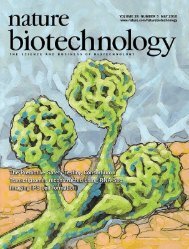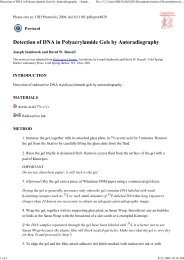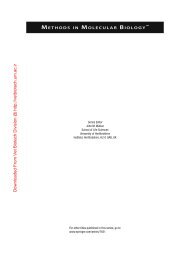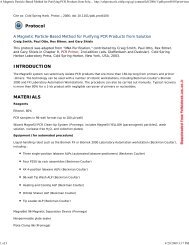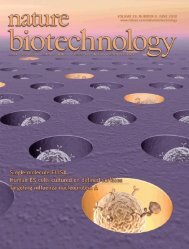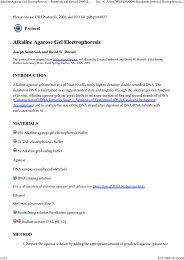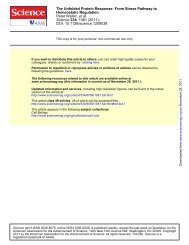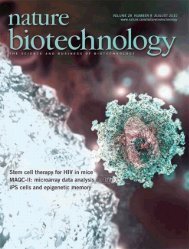Ontology engineering
Ontology engineering
Ontology engineering
You also want an ePaper? Increase the reach of your titles
YUMPU automatically turns print PDFs into web optimized ePapers that Google loves.
l e t t e r saRelative serum factor VIIprotein (%)1201008060402000.01 0.1 1 10 100Factor VII siRNA dose (mg/kg)cMe 2 NOOMe 2 NRROORDLinDMAMe 2 NROORRMe 2 NMe 2 NODLinDAPO RRO Me2 NDLin-K-DMA DLin-KC2-DMA DLin-KC3-DMA DLin-KC4-DMAR =bRelative serum factor VIIprotein (%)1201008060402000.01 0.1 1 10Factor VII siRNA dose (mg/kg)OOROROORRFigure 2 In vivo evaluation of novel cationic lipids. (a) Silencingactivity of DLinDAP (), DLinDMA (), DLin-K-DMA () and DLin-KC2-DMA (•) screening formulations in the mouse Factor VII model.All LNP-siRNA systems were prepared using the preformed vesicle(PFV) method and were composed of ionizable cationic lipid, DSPC,cholesterol and PEG-lipid (40:10:40:10 mol/mol) with a FactorVII siRNA/total lipid ratio of ~0.05 (wt/wt). Data points are expressedas a percentage of PBS control animals and represent group mean(n = 5) ± s.d., and all formulations were compared within the samestudy. (b) Influence of headgroup extensions on the activity ofDLin-K-DMA. DLin-K-DMA () had additional methylene groups addedbetween the DMA headgroup and the ketal ring linker to generateDLin-KC2-DMA (•), DLin-KC3-DMA () and DLin-KC4-DMA (). Theactivity of PFV formulations of each lipid was assessed in the mouseFactor VII model. Data points are expressed as a percentage of PBScontrol animals and represent group mean (n = 4) ± s.d. (c) Chemicalstructures of novel cationic lipids.© 2010 Nature America, Inc. All rights reserved.of using ionizable cationic lipids with pK a s < pH 7.0 to efficientlyformulate nucleic acids at low pH and maintaining a neutral or lowcationic surface charge density at pH 7.4 (ref. 13). This strategy shouldprovide better control of the circulation properties of these systemsand reduce nonspecific disruption of plasma membranes. As positivecharge density is minimal in the blood but increases substantiallyin the acidic environment of the endosome, this should activatethe membrane-destabilizing property of the LNP. Although theseattributes may account for the activity of these systems upon internalizationby hepatocytes, they do not necessarily explain the highlevels of hepatic biodistribution observed for many LNPs, includingSNALP. Although these LNPs do not specifically include a targetingligand to direct them to hepatocytes after systemic administration,it is possible that these LNPs associate with one or more proteins inplasma that may promote hepatocyte endocytosis.The ionizable cationic lipid DLinDMA has proven to be highlyeffective in SNALP, has been extensively tested in rodents and nonhumanprimates, and is now being evaluated in human clinicaltrials. Therefore, we selected it as the starting point for the designand synthesis of novel lipids. We chose the mouse Factor VII model 7 ,as the primary in vivo screening system to assess functional LNPmediateddelivery to hepatocytes. Briefly, C57BL/6 mice receiveda single dose of LNP-formulated Factor VII siRNA through bolustail vein injection and serum was collected from animals 24 h afteradministration to analyze Factor VII protein level. The initial screeningof LNP-siRNA systems was conducted using LNPs prepared bya preformed vesicle method 14 and composed of ionizable cationiclipid, distearoylphosphatidylcholine (DSPC), cholesterol and PEGlipid(40:10:40:10 mol/mol), with a Factor VII siRNA/total lipid ratioof ~0.05 (wt/wt). Although not a bilayer-destabilizing lipid, a smallamount of phosphatidylcholine was incorporated into the LNP tohelp stabilize the LNP both during formulation and while it was incirculation. A short acyl chain PEG-lipid was incorporated into theLNP to control particle size during formulation, but is designed toleave the LNP rapidly upon intravenous injection. As our goal wasto identify novel ionizable cationic lipids for use in LNPs, we aimedto minimize other effects by using a single robust composition andset of formulation conditions suitable for all novel lipids tested. Thepreformed vesicle method employing the composition listed aboveprovides a convenient platform for such testing, but uses a differentformulation process, a different lipid composition and a differentsiRNA/lipid ratio than SNALP. The structure of DLinDMA can bedivided into three main regions: the hydrocarbon chains, the linkerand the headgroup (Fig. 1). A detailed structure-function study toinvestigate the impact of increasing the number of cis double bondsin the hydrocarbon chains found the linoleyl lipid containing twodouble bonds per hydrocarbon chain (DLinDMA) to be optimal 15 .We therefore maintained the linoleyl hydrocarbon chains present inDLinDMA as an element in our lipid design, and focused on optimizingthe linker and headgroup moieties.The linker region in a bilayer structure resides at the membraneinterface, an area of transition between the hydrophobic membranecore and hydrophilic headgroup surface. Our approach to linkermodification of DLinDMA involved introducing groups expected toexhibit different rates of chemical or enzymatic stability and to spana range of hydrophilicity. A variety of these rationally designed lipidswere made, characterized and tested (Supplementary Syntheses 1 andSupplementary Table 1). LNPs based on the ester-containing lipidDLinDAP showed substantially reduced in vivo activity comparedto LNPs based on the alkoxy-containing lipid DLinDMA (Fig. 2).Further, LNPs based on DLin-2-DMAP, a lipid with one alkoxy linkageand one ester linkage, yielded activity intermediate betweenDLinDAP- and DLinDMA-based LNPs (Supplementary Table 1).Although it is uncertain why the ester-containing lipids are considerablyless active in vivo, we speculate that the diester lipid (DLinDAP)is relatively inactive because it is more readily hydrolyzed in vivothan the alkoxy analog (DLinDMA), and therefore, unable to eitherprotect the siRNA adequately before release from the endosomeand/or survive long enough in the endosome to disrupt the membrane.These hypotheses are being investigated. LNPs based on lipidscontaining carbamate or thioether linkages also resulted in dramaticallyreduced in vivo activity. Interestingly, the introduction of a ketalring linker into DLinDMA resulted in LNPs that were ~2.5-fold morepotent in reducing serum Factor VII protein levels relative to theDLinDMA benchmark, with an ED 50 (that is, dose to achieve 50%gene silencing) of ~0.4 mg/kg versus 1 mg/kg, respectively (Fig. 2).Given the importance of positive charge in the mechanismof-actionhypothesis guiding the lipid design, the effects of structuralchanges in the amine-based headgroup were investigated in the contextof DLin-K-DMA as the new benchmark lipid. A series of headgroupmodifications were made, characterized and tested to explorethe effects of size, acid-dissociation constant and number of ionizablegroups (Supplementary Syntheses 2 and Supplementary Table 2).Piperazino, morpholino, trimethylamino or bis-dimethylamino modificationstested were not better than the benchmark dimethylaminoheadgroup of DLin-K-DMA. As an additional parameter, the distancebetween the dimethylamino group and the dioxolane linker was variedby introducing additional methylene groups. This parameter cannature biotechnology VOLUME 28 NUMBER 2 FEBRUARY 2010 173




